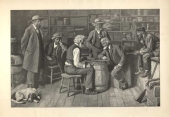The Checker Maven
The World's Most Widely Read Checkers and Draughts Publication
Bob Newell, Editor-in-Chief
Published every Saturday morning in Honolulu, Hawai`i
Noticing missing images? An explanation is here.
The Post-Holiday Blahs

The holidays have speeded by and North America is in the depth of winter. Even here in Waikiki, temperatures drop at night and sometimes get as low as 60F (no, we don't expect much sympathy).
Don't get the post-holiday blahs. Tackling a checkers speed problem will keep the blues away. And to ensure that the desired effect is achieved, we're putting forth a very easy problem. So easy, in fact, that we think you can solve it in a couple of seconds. But, generous as we always are, we'll give you extra time--- a full five seconds, in fact!
Click on the link below to show the problem and start the clock. Think fast!
January 2013 Speed Problem (very easy, 5 seconds)
When you're done, come back and click on Read More to see the solution.![]()
The New Year 2013

Another new year is just around the corner, and The Checker Maven hopes that it will bring you everything that you might wish for. For our part, we intend to bring you another year of checker enjoyment. Let's close out this year with a problem that's relatively easy and with a lot of practical, over the board application.

WHITE
White to Play and Win
W:W28,21,K2,K1:BK22,20,K9,5.
Solving this one won't take you as long as some others, but you'll appreciate the clever way in which a basic principle is applied. Give it your best and close out 2012 in style. Clicking on Read More will show you the solution as always. Some things don't change from year to year!![]()
Deficit Spending

Bill Salot's amazing series of problem composition contests continues. Bill reports receiving enough problem submittals to keep the contest running for quite some time to come. To view, try out, and vote on the latest problem entries, click the link in the left column marked Compositions.
As an example, here's one that's running now called (rather appropriately these days) Deficit Spending.
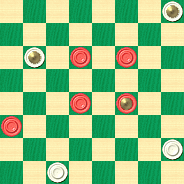
WHITE
White to Play and Draw
W:WK4,K9,28,30:B10,11,18,K19,21.
For the solution and many more fine problems, check out the website.![]()
Holidays 2012

The Checker Maven wishes all our readers the best of the holiday season. No matter what holidays you celebrate and how you celebrate them, checkers is our common bond, and for your holiday enjoyment, we have an unusual problem to present.
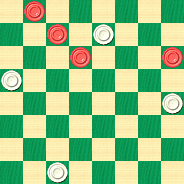
WHITE
White to Play and Win
W:W30,20,13,7:B12,10,6,1.
What makes this problem unusual? We'll give you a huge hint: Moves that you might make almost automatically won't be right.
Solve the problem, check the solution by clicking on Read More, and enjoy the season!![]()
Acclat

Now here's one that puzzled us a great deal. "Acclat" is the pen name of the problemist credited with today's Checker School entry, but we turned up little on the word itself. We found two companies, Acclat Famous Urban Apparel, seemingly not famous at all, and Acclat Business Solutions, at least equally obscure, but little else of any interest.
Acclat sounds French, but the French word is really éclat as in the common expression éclat de rire, a peal of laughter. But acclat? It will remain a mystery.
Hopefully our problem position, shown below, will prove far less mysterious.
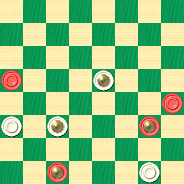
WHITE
White to Play and Win
W:W32,K22,21,K15:BK30,K24,20,13.
We'd say that this one, while certainly not easy, is at least quite a little bit easier than most Checker School selections, and you're likely to have your own éclat de rire when you see the solution. Still, checkers is no laughing matter, so keep a straight face and solve the problem, and then click on Read More for the solution, a sample game, and detailed notes.![]()
Mauro's Seesaw Stroke
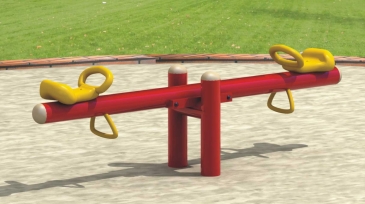
Who wasn't fond of the see-saw or teeter-totter as a child? Of course, there were always those kids on the other end who would slam you down as hard as possible or try to throw you off, but by and large we all had a great deal of fun on these simple but entertaining playground toys.
Today's selection from Willie Ryan's Tricks Traps & Shots of the Checkerboard may definitely throw you off and even possibly slam you, but it's one of the best in his book, and that's saying a lot. Let's tune in to Willie as he tells us what it's all about.
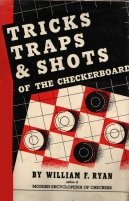
| 11-15 | 21-14 | 24-20---2 | |
| 21-17 | 6-10 | 4-8---3 | |
| 9-13 | 22-17 | 29-25 | |
| 25-21 | 13-22 | 11-15 | |
| 8-11 | 26-17 | 30-26 | |
| 17-14---1 | 15-18 | 8-11---A | |
| 10-17 |
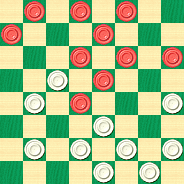
WHITE
White to Play and Win
W:W32,31,28,27,26,25,23,20,17,14:B18,15,12,11,10,7,5,3,2,1.
A---"Though this move loses, I can find no published play showing how to beat it. In view of the very delicate nature of the win after 8-11 is played, it appears that the possibilities of the gambit have been overlooked. Oliver J. Mauro. At this point, the correct play for black is: 15-19, 23-16, 12-19, 27-23, 18-27, 32-16, 8-12, 16-11*, 7-16, 20-11, 2-7, 11-2, 1-6, 2-9, 12-16, 14-7, 5-30, 28-24*, 30-23, 24-20, 3-10, 20-11. Sweeney vs. Truax.
Another choice at A is 2-6, but white wins against this move with: 26-22, 6-9, 23-19, 15-24, 22-6, 1-10, 28-19, 9-18, 19-16, 12-19, 27-23, 19-26, 31-6. James Wyllie."
1---While it certainly can't be said that this move loses, it's surely inferior. 30-25 or 24-19 is best here---Ed..
2---White makes his situation worse and ends up with a definitely inferior position. 23-19 is better---Ed..
3---With this move Black dissipates all his advantage. 1-6 would keep a clear edge and 2-6 is almost as good---Ed.
There isn't any doubt that this one is tough, perhaps unfairly so, and we think it may be within the capabilities of only the top players. Still, it's really, really good and definitely worth your time, even if you end up looking at the solution before very long. Make use of your computer to explore various alternative lines and enjoy this fascinating position. You'll understand Willie's title of "Seesaw" when you see the various lines of play in the solution.
So don't be swayed by the apparent difficulty; take a few swings and bear with the inevitable ups and downs. Then click on Read More to see the solution and detailed notes.![]()
Eighth Anniversary
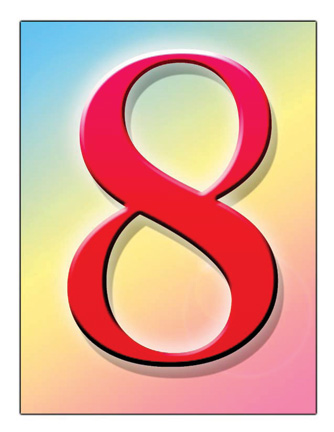
With today's publication, The Checker Maven completes eight years of publication without a single missed edition.
We've mentioned before that our new business plan calls for fifteen years of publication rather than the ten years contemplated in our original plan. We hope to be blessed to continue to reach our annual milestones, and we thank all of our many readers for making us the most widely read Anglo-American checkers publication on earth.
Anniversary celebrations at The Checker Maven often involve the publication of a new work of checker fiction, but this year instead we're able to release the long-awaited reissue of Grover and Wiswell's Let's Play Checkers. Continue on to the article below for all the details.![]()
Let's Play Checkers
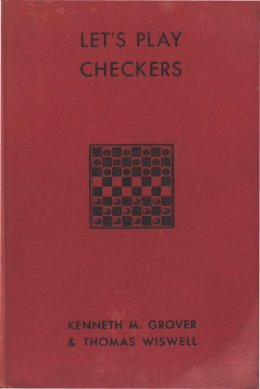
It's been a long time coming, but thanks to the kind approval of the Grover estate, we're at long last able to offer a new electronic edition of the Ken Grover and Tom Wiswell classic, Let's Play Checkers.
This book, originally published back in 1940, went through a number of editions, most of them during wartime. The copies have not fared well. Wartime paper restrictions limited the quality and especially the durability of the books, and although used copies can still be had, they vary greatly as to their condition.
Our new edition features modern typography and clear, crisp board diagrams, while still retaining all of the wonderful content and "feel" of the original.
Let's Play Checkers was not your typical checker book. Though it did have the usual "Game Section" and "Problem Section" structure common to nearly all books of the time, the emphasis was decidedly different. Let's Play Checkers is an opening repertoire book for the go-as-you-please (GAYP) player.
Repertoire books, which feature detailed study of just a few suggested game openings, are common in chess but most rare in checkers. Let's Play Checkers' repertoire approach will appeal to the intermediate GAYP player, while its sparkling collection of 100 problems will attract players of every skill level.
Here's an example, composed by co-author Ken Grover.
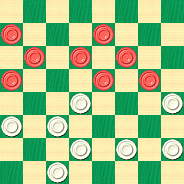
WHITE
White to Play and Win
W:W30,28,27,26,22,21,20,18:B16,15,13,11,10,9,7,5.
This is a book you'll definitely want, even if you already have a print copy, and it's yours for the taking, completely free of charge. You can download it here. So what are you waiting for?![]()
The Fugitive King

Perhaps the most famous royal fugitive, King David, is to be found in the Scriptures. He spent 15 years in exile, fleeing from King Saul. Strictly speaking, David wasn't yet a king during his fugitive years, but he is nevertheless often referred to as "The Fugitive King."
Today's entry in our Checker School series deals with a checker-related "Fugitive King" theme. This problem is reminiscent of the "Fortress" situations that we've covered in several earlier columns, although here if Black plays correctly the White king will find no refuge.
WHITE
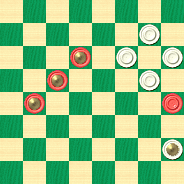
BLACK
Black to Play and Win
B:W25,22,21,17,K5:BK23,K19,K16,13.
The problem requires very precise play and the solution is not short. We certainly have to rate this one as quite difficult. But don't go on the lam; try to solve it! When you're finished, run your mouse over to Read More to see the solution, a sample game, and detailed notes.![]()
Thanksgiving 2012
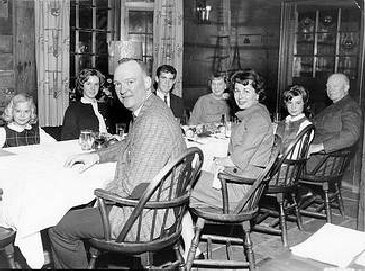
Thanksgiving, our favorite all-American holiday, is soon upon us, and we hope you enjoy the celebration as much as we do. Family dinners, such as the one shown above, are a holiday tradition. Can you recognize the family in the photo?
As usual at this time of year, we turn to our favorite all-American checker problemist, Tom Wiswell, for today's selection.
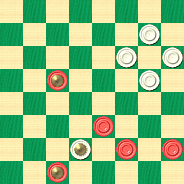
BLACK
Black to Play and Win
B:W25,22,21,17,K7:BK19,10,6,5,K3.
Add a few moments of checker enjoyment to your holiday. Solve the problem after your main course and before dessert. Then have a second helping of turkey and a slice of pumpkin pie. Mr. Wiswell describes this problem as "more amusing than difficult." While it requires precise play, it certainly isn't as difficult as some of his others.
When you've found your solution, click on Read More to verify your moves.![]()
The Checker Maven is produced at editorial offices in Honolulu, Hawai`i, as a completely non-commercial public service from which no profit is obtained or sought. Original material is Copyright © 2004-2025 Avi Gobbler Publishing. Other material is public domain, as attributed, or licensed under Creative Commons. Information presented on this site is offered as-is, at no cost, and bears no express or implied warranty as to accuracy or usability. You agree that you use such information entirely at your own risk. No liabilities of any kind under any legal theory whatsoever are accepted. The Checker Maven is dedicated to the memory of Mr. Bob Newell, Sr.

